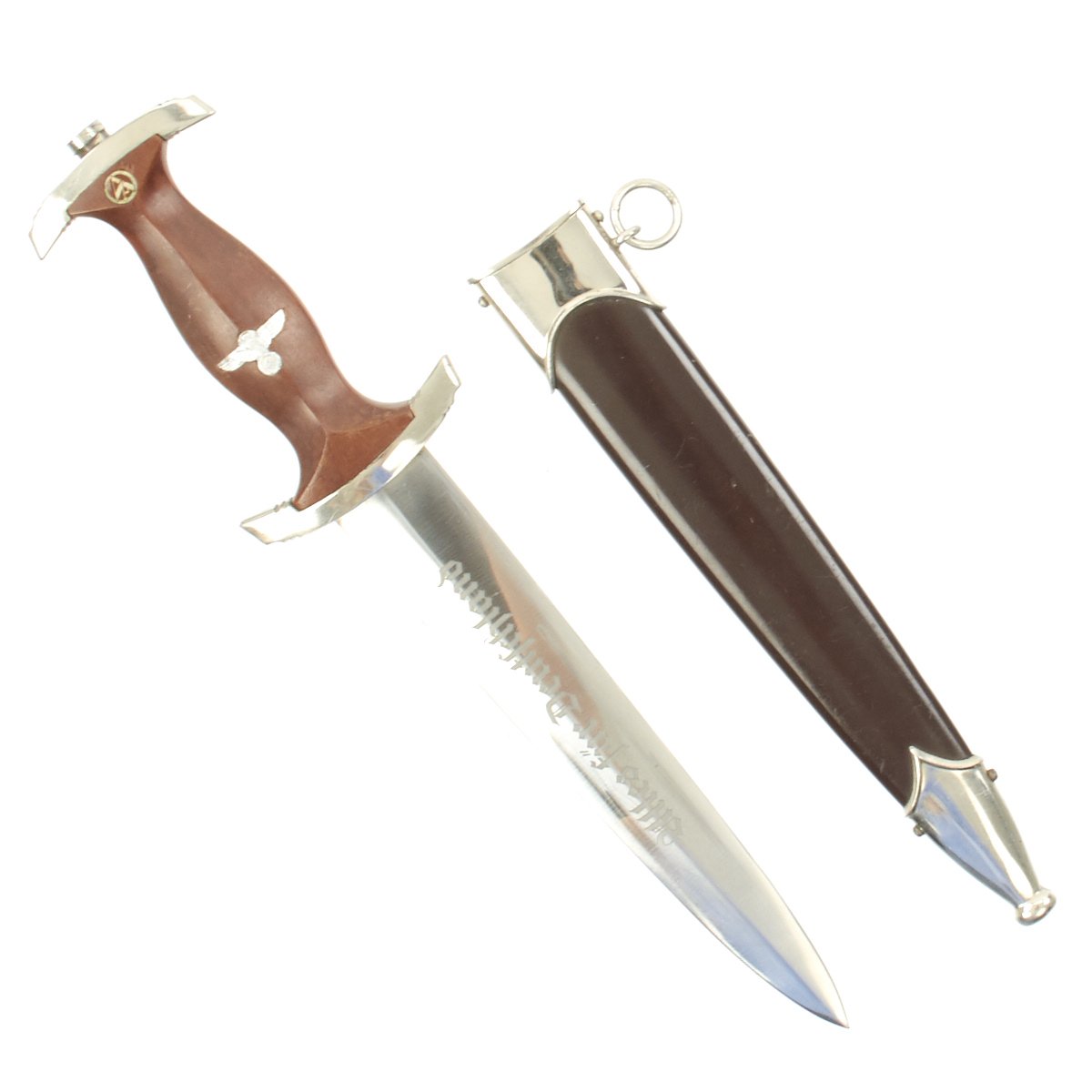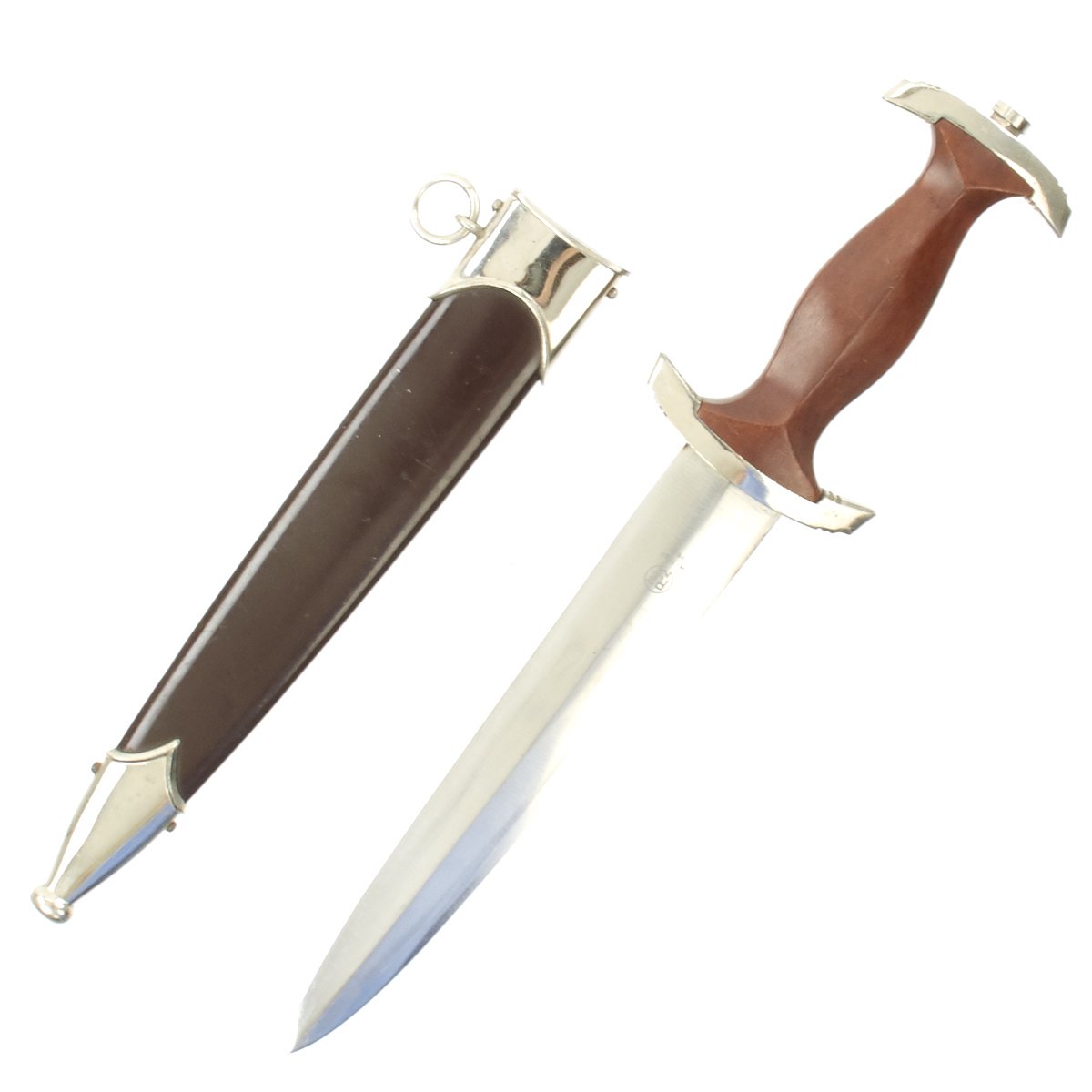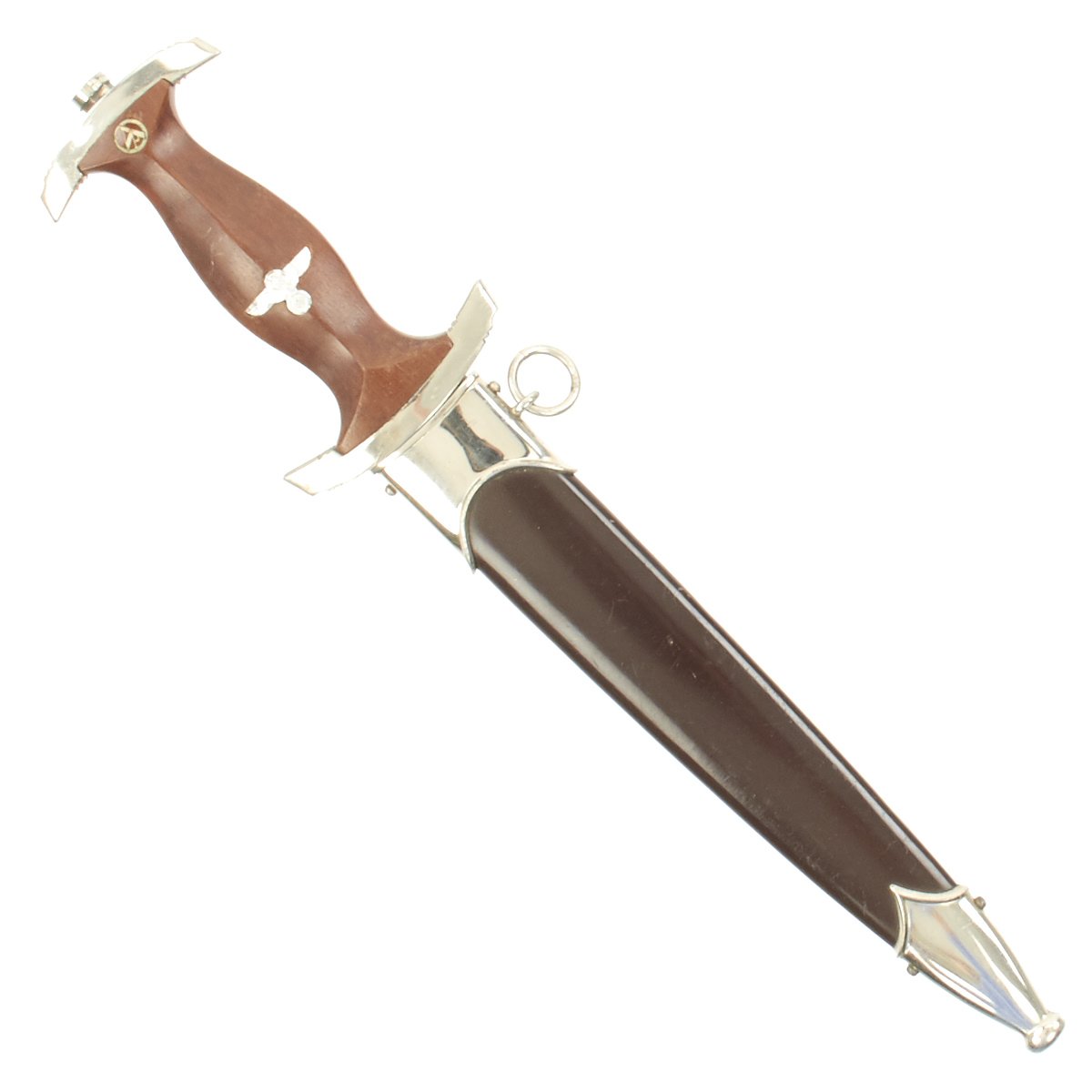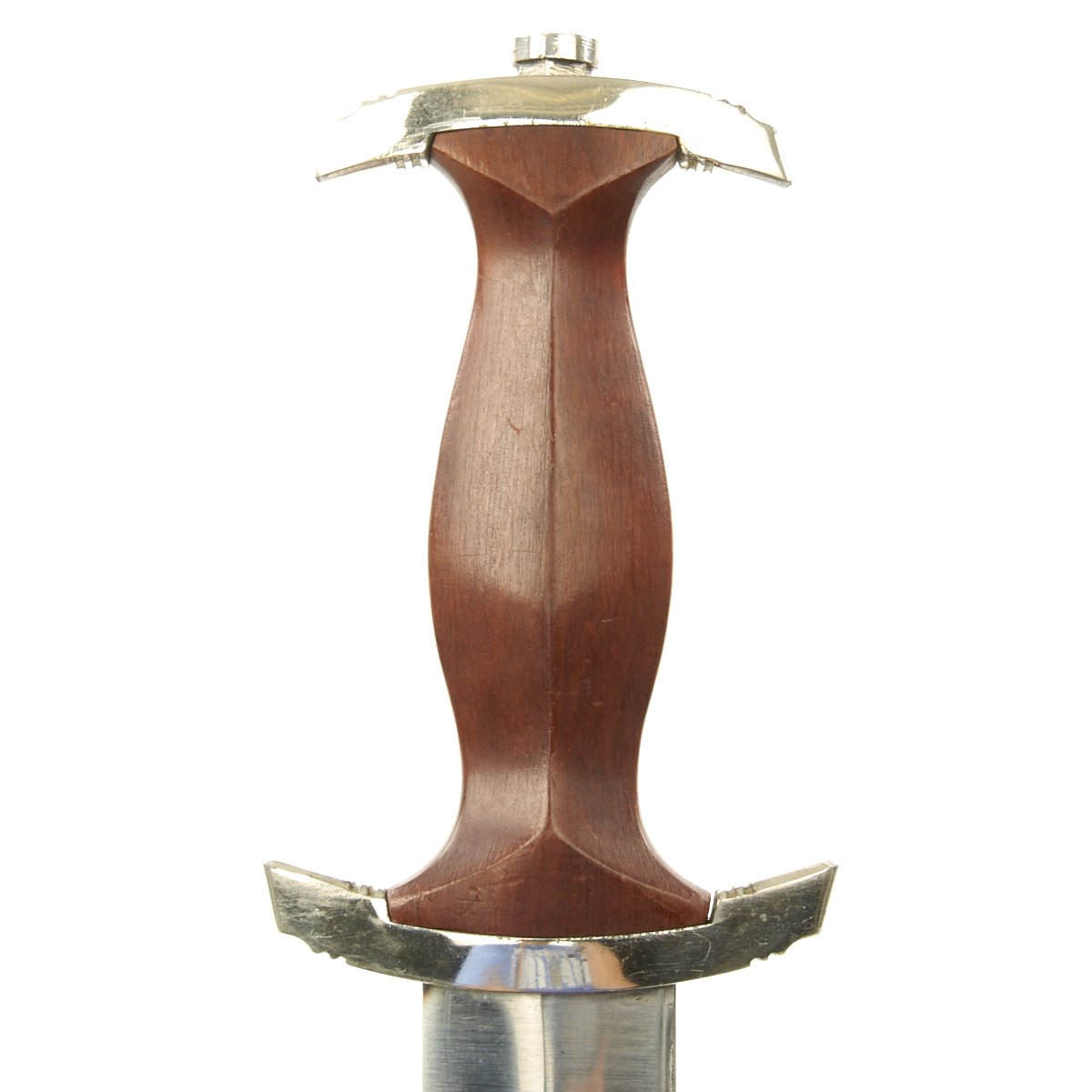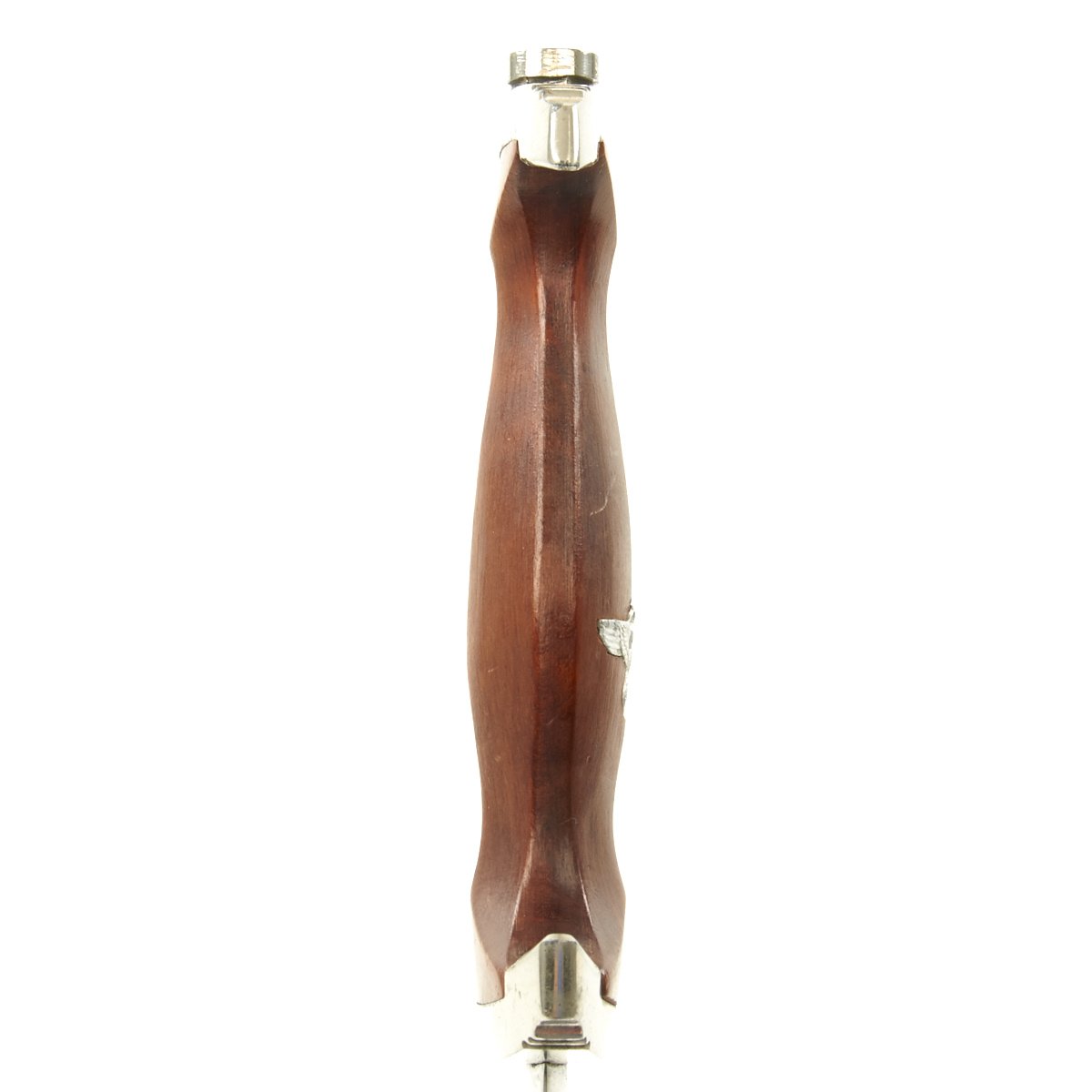Original German WWII 1941 dated SA Dagger with Scabbard by Tigerwerk Lauterjung & Co. – RZM M7/68 Original Items
$ 795,00 $ 238,50
Original Item: Only One Available. This mid-war 1941 produced SA Dagger has nickel-plated fittings throughout. The crossguards and tang nut are nickel plated aluminum, and have almost all the plating intact, with just a bit of light oxidation in places. There is not any major chipping or dents in the fittings, just the usual patina of age.
The grip is a fine product having a nice red mahogany tone in the surfaces and having medium center ridge construction. This grip is in very good condition with great grain, and fits the crossguards nicely. Just a bit of missing wood around the symbol button, which is nicely set having 100% intact enameling, with the plating intact as well, with just a bit of oxidation. The details are still there to the aluminum eagle, including the beak, breast feathering, wing feathering, talons, wreath and mobile swas.
The scabbard shell is straight throughout and has good original chocolate brown paint. It has a minimal crazing and chipping, and overall it is still bright and rates at about 95%. The scabbard shell is equipped with fine matching nickel-plated steel based mounts. These mounts are in great condition overall, with only a few small dents on the lower ball. They nicely match the crossguards and are complete with all four dome head screws.
The blade of this example is in excellent condition and has almost all of its factory crossgrain. There is a bit of oxidation in places, but nothing major. There are runner marks from the scabbard, and just a bit of attempted sharpening at the edge. The acid-etched Alles für Deutschland SA motto is crisp, and still retains most of the factory darkening. The reverse ricasso is etched with a double circle with RZM logo in the middle. This circle is placed over additional markings and a date: RZM M7/68 / 1941. This indicates 1941 manufacture by Tigerwerk Lauterjung & Co..
The Reichszeugmeisterei, or RZM, was was based at the Brown house in Munich and NSDAP party headquarters in Berlin. The RZM ensured that the manufacturers of military items were consistent in design, quality of materials and other characteristics of the items. It also defined standards of design, manufacturing and quality and published an authoritative color chart for textiles.
The M7 in the code stands for knives/daggers, contractor 68 stands for firm Lauterjung & Co., Tiger Stahlwaren- und Waffenfabrik in Solingen, the legendary “City of Blades” in Western Germany. Their trademark was a Tiger, and their factory was thus often referred to as Tigerwerk (Tiger Works).
A very nice mid-war example of an SA dagger from a known maker. Ready to display!
History of the SA-
The SA or Brown Shirts, were a private political formation which Adolf AH and the NSDAP used to maintain order at organized Party meetings and demonstrations. The group was formed in 1921, and grew to a huge force of nearly 3,000,000 men by the later 1930’s. To instill esprit de corps, as well as create employment for the Blade City of Solingen, it was decided each SA man would carry a dagger with his Brown Shirt uniform. Huge quantities needed to be produced to accommodate the demand. The dagger initially was produced of hand-fitted nickel mounts with attractive finished wood grip and brown anodized (a bluing process) finished scabbard.
The blade was etched with the SA motto, Alles für Deutschland. Examples produced prior to 1935 were stamped with the German sector of the SA group on reverse lower crossguard. Later examples underwent standardization through the RZM ministry. These pieces were produced of cheaper plated zinc-base fittings and scabbards were simply painted brown.
Prior to his “unmasking” as a traitor, Ernst Röhm was the leader of the SA. In 1934, he distributed approximately 100,000 SA daggers with his personal inscription on the reverse blade. These daggers were to honor individuals who had served with the SA prior to December, 1931. Other than the inscription, these pieces were identical to the standard M1933 SA dagger. After the Röhm purge, the inscription was ordered to be removed. Many examples were returned to the factory for grinding. Others were simply ground in the field by whatever means were available. Examples will occasionally be encountered with remnants of the original inscription remaining on the blade, but mostly none will remain. Some blades exist with an intact inscription, reflecting only the removal of the Röhm signature. Very very rarely is an example seen with a full, untouched inscription, as the holder would have surely risked a charge of treason.
Fast Shipping with Professional Packaging
Thanks to our longstanding association with UPS FedEx DHL, and other major international carriers, we are able to provide a range of shipping options. Our warehouse staff is expertly trained and will wrap your products according to our exact and precise specifications. Prior to shipping, your goods will be thoroughly examined and securely secured. We ship to thousands clients each day across multiple countries. This shows how we're dedicated to be the largest retailer on the internet. Warehouses and distribution centres can be located throughout Europe as well as the USA.
Note: Orders with more than one item will be assigned a processing date depending on the item.
Before shipping before shipping, we'll conduct a thorough inspection of the items you have ordered. Today, the majority of orders will be delivered within 48 hours. The delivery time will be between 3-7 days.
Returns
The stock is dynamic and we cannot completely manage it because multiple stakeholders are involved, including our factory and warehouse. So the actual stock may alter at any time. It's possible that you may not receive your order once the order has been made.
Our policy is valid for a period of 30 days. If you don't receive the product within 30 days, we are not able to issue a refund or an exchange.
You can only return an item if it is unused and in the same state as the day you received it. You must have the item in its original packaging.
Related products
Uncategorized
Uncategorized
Uncategorized
Uncategorized
Uncategorized
Uncategorized
Uncategorized
Uncategorized
Uncategorized
Uncategorized
Uncategorized
Australian WWII Owen MK1 Machine Carbine SMG Custom Fabricated Replica with Sling Original Items
Uncategorized
Uncategorized
Uncategorized
Band of Brothers ORIGINAL GERMAN WWII Le. F.H. 18 10.5cm ARTILLERY PIECE Original Items
Uncategorized
Uncategorized
